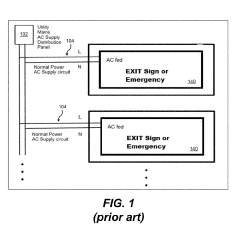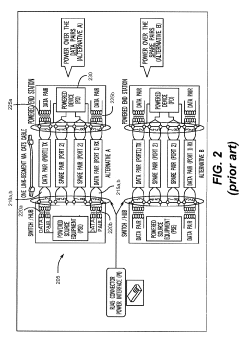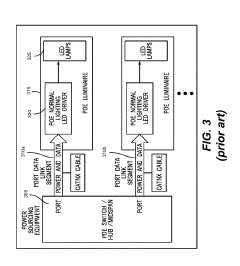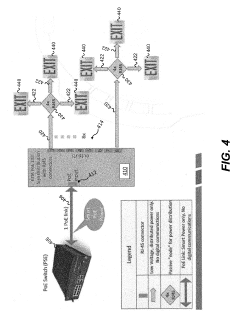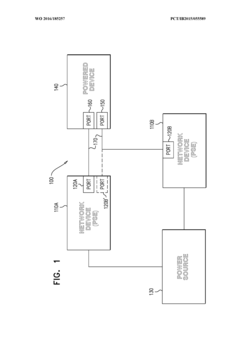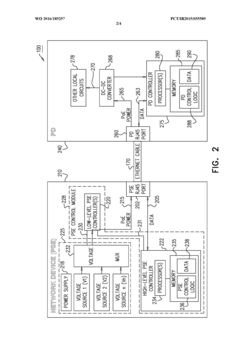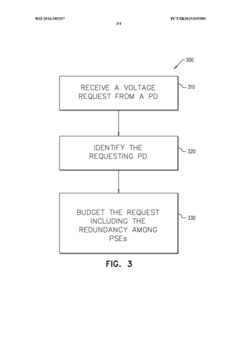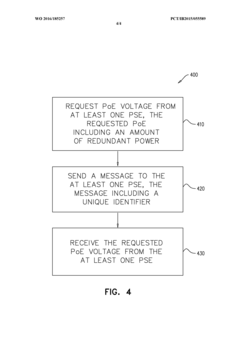Measure PoE++ Performance Under Variable Loads
SEP 24, 202510 MIN READ
Generate Your Research Report Instantly with AI Agent
Patsnap Eureka helps you evaluate technical feasibility & market potential.
PoE++ Technology Background and Objectives
Power over Ethernet (PoE) technology has evolved significantly since its inception in the early 2000s, transforming from a simple power delivery mechanism to a sophisticated system capable of powering increasingly demanding devices. The latest iteration, PoE++ (also known as IEEE 802.3bt), represents a substantial leap forward in power delivery capabilities over standard Ethernet cabling. This evolution has been driven by the growing need for higher power delivery to support advanced networked devices while maintaining the cost-effectiveness and convenience of a single-cable solution.
The development trajectory of PoE technology shows clear progression through several standards: IEEE 802.3af (PoE) delivering up to 15.4W, IEEE 802.3at (PoE+) providing up to 30W, and finally IEEE 802.3bt (PoE++) enabling up to 60W (Type 3) or 100W (Type 4) of power. This progression reflects the industry's response to the increasing power demands of modern network endpoints such as high-performance wireless access points, pan-tilt-zoom cameras, digital signage, and IoT gateways.
The primary technical objective in measuring PoE++ performance under variable loads is to understand how the technology maintains efficiency, reliability, and safety across different operational scenarios. This understanding is crucial as PoE++ systems are increasingly deployed in critical infrastructure where performance degradation could have significant consequences. Variable loads present particular challenges to power delivery systems, potentially causing voltage fluctuations, thermal issues, or reduced efficiency.
Another key objective is to establish standardized methodologies for evaluating PoE++ systems under real-world conditions. Current testing frameworks often focus on static loads, which may not accurately represent the dynamic power requirements of modern networked devices. Developing comprehensive testing protocols for variable load scenarios will enable more accurate performance predictions and better system designs.
From an industry perspective, the goal is to push PoE++ technology toward greater power efficiency while maintaining backward compatibility with existing infrastructure. This includes minimizing power loss during transmission, optimizing power negotiation protocols, and ensuring reliable operation across various cable qualities and lengths. The industry is particularly focused on improving energy management features to support green initiatives and reduce operational costs.
Looking forward, the technical trajectory for PoE++ includes potential integration with smart building systems, enhanced power management capabilities, and possible convergence with other power delivery technologies. Understanding performance under variable loads will be essential for these future applications, particularly as the technology expands beyond traditional IT environments into broader industrial and commercial settings.
The development trajectory of PoE technology shows clear progression through several standards: IEEE 802.3af (PoE) delivering up to 15.4W, IEEE 802.3at (PoE+) providing up to 30W, and finally IEEE 802.3bt (PoE++) enabling up to 60W (Type 3) or 100W (Type 4) of power. This progression reflects the industry's response to the increasing power demands of modern network endpoints such as high-performance wireless access points, pan-tilt-zoom cameras, digital signage, and IoT gateways.
The primary technical objective in measuring PoE++ performance under variable loads is to understand how the technology maintains efficiency, reliability, and safety across different operational scenarios. This understanding is crucial as PoE++ systems are increasingly deployed in critical infrastructure where performance degradation could have significant consequences. Variable loads present particular challenges to power delivery systems, potentially causing voltage fluctuations, thermal issues, or reduced efficiency.
Another key objective is to establish standardized methodologies for evaluating PoE++ systems under real-world conditions. Current testing frameworks often focus on static loads, which may not accurately represent the dynamic power requirements of modern networked devices. Developing comprehensive testing protocols for variable load scenarios will enable more accurate performance predictions and better system designs.
From an industry perspective, the goal is to push PoE++ technology toward greater power efficiency while maintaining backward compatibility with existing infrastructure. This includes minimizing power loss during transmission, optimizing power negotiation protocols, and ensuring reliable operation across various cable qualities and lengths. The industry is particularly focused on improving energy management features to support green initiatives and reduce operational costs.
Looking forward, the technical trajectory for PoE++ includes potential integration with smart building systems, enhanced power management capabilities, and possible convergence with other power delivery technologies. Understanding performance under variable loads will be essential for these future applications, particularly as the technology expands beyond traditional IT environments into broader industrial and commercial settings.
Market Demand Analysis for High-Power PoE Solutions
The global market for Power over Ethernet (PoE) solutions is experiencing robust growth, driven primarily by the increasing adoption of IoT devices, smart buildings, and the expansion of network infrastructure. The demand for high-power PoE solutions, particularly PoE++ (IEEE 802.3bt), has been accelerating as power-hungry devices such as pan-tilt-zoom cameras, digital signage, thin clients, and advanced wireless access points become more prevalent in enterprise environments.
Market research indicates that the global PoE market is projected to grow at a compound annual growth rate of 12.6% through 2026, with the high-power segment showing even stronger momentum at approximately 15.8% growth. This acceleration is largely attributed to the capability of PoE++ to deliver up to 90W of power, addressing the requirements of devices that traditional PoE standards could not support.
Industry surveys reveal that IT managers and network administrators increasingly prefer integrated power and data solutions to reduce installation complexity and operational costs. Nearly 68% of enterprise network upgrades now include considerations for PoE capability, with 42% specifically requiring high-power PoE options to future-proof their infrastructure investments.
The healthcare sector represents one of the fastest-growing vertical markets for high-power PoE solutions, with applications ranging from medical imaging displays to patient monitoring systems. Similarly, the retail sector is rapidly adopting PoE-powered digital signage and interactive kiosks, creating substantial demand for reliable high-power delivery systems.
Geographically, North America continues to lead the market with approximately 38% share, followed by Europe and Asia-Pacific. However, the Asia-Pacific region is expected to witness the highest growth rate due to rapid infrastructure development and smart city initiatives in countries like China, India, and Singapore.
A significant market driver is the increasing focus on energy efficiency and sustainability. High-power PoE solutions with advanced power management capabilities are seeing heightened demand as organizations seek to optimize energy consumption while maintaining performance under variable loads. This trend aligns with global energy efficiency regulations and corporate sustainability goals.
Customer feedback indicates growing concerns about performance consistency under variable load conditions, with 57% of network administrators citing reliable power delivery as a critical factor in their purchasing decisions. This highlights the importance of comprehensive performance testing methodologies for PoE++ systems under diverse operational scenarios.
The market is also witnessing increased demand for solutions that offer granular power monitoring and management capabilities, allowing organizations to track energy usage patterns and implement dynamic power allocation strategies based on actual device requirements and usage patterns.
Market research indicates that the global PoE market is projected to grow at a compound annual growth rate of 12.6% through 2026, with the high-power segment showing even stronger momentum at approximately 15.8% growth. This acceleration is largely attributed to the capability of PoE++ to deliver up to 90W of power, addressing the requirements of devices that traditional PoE standards could not support.
Industry surveys reveal that IT managers and network administrators increasingly prefer integrated power and data solutions to reduce installation complexity and operational costs. Nearly 68% of enterprise network upgrades now include considerations for PoE capability, with 42% specifically requiring high-power PoE options to future-proof their infrastructure investments.
The healthcare sector represents one of the fastest-growing vertical markets for high-power PoE solutions, with applications ranging from medical imaging displays to patient monitoring systems. Similarly, the retail sector is rapidly adopting PoE-powered digital signage and interactive kiosks, creating substantial demand for reliable high-power delivery systems.
Geographically, North America continues to lead the market with approximately 38% share, followed by Europe and Asia-Pacific. However, the Asia-Pacific region is expected to witness the highest growth rate due to rapid infrastructure development and smart city initiatives in countries like China, India, and Singapore.
A significant market driver is the increasing focus on energy efficiency and sustainability. High-power PoE solutions with advanced power management capabilities are seeing heightened demand as organizations seek to optimize energy consumption while maintaining performance under variable loads. This trend aligns with global energy efficiency regulations and corporate sustainability goals.
Customer feedback indicates growing concerns about performance consistency under variable load conditions, with 57% of network administrators citing reliable power delivery as a critical factor in their purchasing decisions. This highlights the importance of comprehensive performance testing methodologies for PoE++ systems under diverse operational scenarios.
The market is also witnessing increased demand for solutions that offer granular power monitoring and management capabilities, allowing organizations to track energy usage patterns and implement dynamic power allocation strategies based on actual device requirements and usage patterns.
Current PoE++ Technical Challenges Under Variable Loads
Power over Ethernet Plus Plus (PoE++) technology, defined by IEEE 802.3bt standard, faces several significant technical challenges when operating under variable load conditions. The primary challenge stems from the dynamic power requirements of modern IoT devices, which can fluctuate dramatically based on operational states. These fluctuations create substantial stress on power management systems, potentially leading to voltage instabilities and reduced efficiency.
Power allocation mechanisms in PoE++ systems struggle to adapt quickly enough to rapid load changes, particularly in environments with multiple connected devices exhibiting different power consumption patterns. The standard's theoretical maximum of 90-100W per port becomes difficult to maintain consistently when devices frequently transition between low-power and high-power states, creating momentary power surges that exceed allocated thresholds.
Thermal management presents another critical challenge under variable loads. Power dissipation during load transitions generates heat that must be effectively managed to prevent component degradation. Current heat dissipation solutions often prove inadequate during rapid load cycling, leading to potential thermal runaway situations and reduced component lifespan.
Cable quality and infrastructure limitations further compound these challenges. While Category 6A cabling is recommended for maximum PoE++ performance, many existing installations utilize lower-grade cabling that exhibits higher resistance under load, resulting in greater power loss and heat generation during variable load conditions. This infrastructure constraint significantly impacts real-world performance compared to laboratory specifications.
Power negotiation protocols between Powered Devices (PDs) and Power Sourcing Equipment (PSE) face timing challenges during rapid load changes. The current handshaking mechanisms were not designed for highly dynamic power environments, creating latency issues that can result in momentary power shortfalls during critical operational transitions.
Measurement accuracy represents a substantial technical hurdle. Current sensing technologies struggle to capture microsecond-level power fluctuations accurately, leading to imprecise power delivery and potential system instabilities. This measurement challenge becomes particularly pronounced in industrial environments where electromagnetic interference can further degrade sensing precision.
Backward compatibility with earlier PoE standards introduces additional complexity when managing variable loads. Systems must maintain interoperability while accommodating the wider power range and more sophisticated power requirements of modern devices, often resulting in compromised performance under dynamic conditions.
Energy efficiency optimization remains problematic, as current power management algorithms typically prioritize stable delivery over efficiency. This approach leads to significant energy wastage during low-power periods as systems maintain higher power states to accommodate potential load increases.
Power allocation mechanisms in PoE++ systems struggle to adapt quickly enough to rapid load changes, particularly in environments with multiple connected devices exhibiting different power consumption patterns. The standard's theoretical maximum of 90-100W per port becomes difficult to maintain consistently when devices frequently transition between low-power and high-power states, creating momentary power surges that exceed allocated thresholds.
Thermal management presents another critical challenge under variable loads. Power dissipation during load transitions generates heat that must be effectively managed to prevent component degradation. Current heat dissipation solutions often prove inadequate during rapid load cycling, leading to potential thermal runaway situations and reduced component lifespan.
Cable quality and infrastructure limitations further compound these challenges. While Category 6A cabling is recommended for maximum PoE++ performance, many existing installations utilize lower-grade cabling that exhibits higher resistance under load, resulting in greater power loss and heat generation during variable load conditions. This infrastructure constraint significantly impacts real-world performance compared to laboratory specifications.
Power negotiation protocols between Powered Devices (PDs) and Power Sourcing Equipment (PSE) face timing challenges during rapid load changes. The current handshaking mechanisms were not designed for highly dynamic power environments, creating latency issues that can result in momentary power shortfalls during critical operational transitions.
Measurement accuracy represents a substantial technical hurdle. Current sensing technologies struggle to capture microsecond-level power fluctuations accurately, leading to imprecise power delivery and potential system instabilities. This measurement challenge becomes particularly pronounced in industrial environments where electromagnetic interference can further degrade sensing precision.
Backward compatibility with earlier PoE standards introduces additional complexity when managing variable loads. Systems must maintain interoperability while accommodating the wider power range and more sophisticated power requirements of modern devices, often resulting in compromised performance under dynamic conditions.
Energy efficiency optimization remains problematic, as current power management algorithms typically prioritize stable delivery over efficiency. This approach leads to significant energy wastage during low-power periods as systems maintain higher power states to accommodate potential load increases.
Current Methodologies for PoE++ Performance Measurement
01 Power delivery capabilities of PoE++
PoE++ (IEEE 802.3bt) significantly increases power delivery capabilities over previous PoE standards, allowing for up to 90-100W of power to be delivered through Ethernet cables. This enhanced power capacity enables the support of higher-power devices such as pan-tilt-zoom cameras, digital signage, and multi-radio wireless access points. The improved performance is achieved through utilizing all four pairs of wires in the Ethernet cable for power transmission, compared to just two pairs in earlier standards.- Power Management and Efficiency in PoE++ Systems: Power over Ethernet Plus Plus (PoE++) systems incorporate advanced power management techniques to improve efficiency and performance. These systems can intelligently allocate power resources based on device requirements, implement power saving modes during periods of low activity, and optimize power delivery across network infrastructure. The enhanced power management capabilities allow for more efficient operation of high-power devices while minimizing energy waste.
- Enhanced Power Delivery Capabilities: PoE++ technology offers significantly increased power delivery capabilities compared to previous PoE standards. With support for delivering up to 90W of power over standard Ethernet cables, PoE++ enables the connection of higher-power devices such as pan-tilt-zoom cameras, digital signage displays, and multi-radio wireless access points. This enhanced power delivery is achieved through improved negotiation protocols, more efficient power sourcing equipment, and advanced circuit designs that maintain signal integrity while delivering higher current.
- Network Architecture and Integration: PoE++ systems require specific network architecture considerations to ensure optimal performance. This includes the design of power sourcing equipment (PSE), powered device (PD) interfaces, and the network infrastructure connecting them. Integration challenges involve maintaining backward compatibility with older PoE standards while supporting the higher power capabilities of PoE++. Advanced network management protocols enable seamless integration of PoE++ devices into existing networks while providing enhanced monitoring and control capabilities.
- Thermal Management and Safety Features: Due to the higher power levels in PoE++ systems, effective thermal management is crucial for maintaining performance and ensuring device longevity. Advanced thermal management techniques include temperature monitoring, adaptive power adjustment based on thermal conditions, and improved heat dissipation designs. Safety features such as overcurrent protection, short circuit detection, and voltage regulation are implemented to prevent damage to connected devices and infrastructure while maintaining compliance with electrical safety standards.
- Performance Monitoring and Diagnostics: PoE++ systems incorporate advanced monitoring and diagnostic capabilities to ensure optimal performance. These features include real-time power consumption tracking, automated fault detection, performance analytics, and predictive maintenance capabilities. Network administrators can monitor power usage patterns, identify potential issues before they cause disruptions, and optimize system configurations for improved efficiency and reliability. These monitoring systems often integrate with network management platforms to provide comprehensive visibility into both power and data aspects of the network.
02 Power management and efficiency in PoE++ systems
Advanced power management techniques are essential for optimizing PoE++ performance. These include dynamic power allocation, where power is allocated based on actual device needs rather than maximum ratings, and intelligent load balancing across multiple power sources. Energy efficiency features such as sleep modes during periods of inactivity and gradual power-up sequences help reduce overall power consumption while maintaining system reliability. These management systems can significantly improve the overall efficiency of PoE++ deployments.Expand Specific Solutions03 Thermal considerations and heat dissipation
The increased power delivery of PoE++ creates greater thermal challenges in network infrastructure. Effective heat dissipation methods are crucial for maintaining system reliability and preventing performance degradation. Solutions include improved heat sink designs, strategic component placement, and active cooling systems for high-density deployments. Thermal management is particularly important in enclosed spaces or when multiple PoE++ ports are operating at maximum capacity simultaneously.Expand Specific Solutions04 Compatibility and interoperability with existing infrastructure
PoE++ systems are designed with backward compatibility to work with existing PoE and PoE+ devices. This interoperability allows for gradual infrastructure upgrades without requiring complete system overhauls. Auto-negotiation protocols enable devices to determine the appropriate power levels, ensuring that older devices receive only the power they can safely handle. This compatibility extends to both powered devices and power sourcing equipment, facilitating smooth transitions to higher power capabilities.Expand Specific Solutions05 Network performance and data transmission with PoE++
PoE++ maintains high-speed data transmission capabilities while delivering increased power. Advanced signal processing techniques minimize power-induced interference on data signals, ensuring reliable gigabit and multi-gigabit Ethernet performance. Cable quality becomes increasingly important at higher power levels to prevent signal degradation over distance. Some implementations include adaptive techniques that adjust power delivery parameters based on cable characteristics and environmental conditions to optimize both power delivery and data transmission performance.Expand Specific Solutions
Key Industry Players in PoE++ Technology Ecosystem
The Power over Ethernet Plus Plus (PoE++) market is currently in a growth phase, with increasing adoption across enterprise networks and IoT deployments. The global PoE market is projected to reach approximately $2 billion by 2025, with PoE++ representing the fastest-growing segment due to its higher power delivery capabilities. Technologically, the field is maturing rapidly with key players driving innovation in variable load management. Cisco Technology leads with comprehensive enterprise solutions, while Huawei and ZTE offer competitive integrated systems. Broadcom (Avago) dominates the semiconductor component space, with specialized contributions from IC Plus and Realtek in chipset development. New H3C and Ruijie Networks are gaining market share with cost-effective implementations, particularly in Asian markets. The technology's performance under variable loads remains a critical differentiator as power-hungry applications like high-power wireless access points and surveillance systems drive adoption.
Huawei Technologies Co., Ltd.
Technical Solution: Huawei's approach to measuring PoE++ performance under variable loads centers on their intelligent power management system that combines hardware sensors with AI-driven analytics. Their solution implements high-precision current and voltage monitoring at microsecond intervals, capturing detailed power signatures across different load scenarios. Huawei's testing framework incorporates specialized load simulation equipment that can generate both static and dynamic power demands, mimicking real-world device behavior patterns. Their PoE++ controllers feature adaptive power regulation that continuously optimizes delivery based on connected device requirements, supporting the full IEEE 802.3bt standard with power delivery up to 90W. The system employs distributed measurement points throughout the network infrastructure to create comprehensive power maps that identify potential bottlenecks or inefficiencies. Huawei's solution also includes thermal modeling capabilities that correlate power consumption with heat generation, ensuring reliable operation even under sustained high-load conditions.
Strengths: Advanced AI-based power optimization algorithms that adapt to changing network conditions; comprehensive data collection enabling detailed performance analysis; integrated thermal management for improved reliability. Weaknesses: Higher initial deployment costs; potential compatibility challenges with legacy infrastructure; complex configuration requirements that may necessitate specialized training.
Cisco Technology, Inc.
Technical Solution: Cisco's PoE++ (IEEE 802.3bt) performance measurement solution employs a comprehensive testing framework that utilizes real-time power monitoring across variable loads. Their approach integrates specialized hardware with Cisco IOS software to continuously monitor power consumption, voltage stability, and thermal performance. The system implements dynamic power allocation algorithms that can adjust power delivery based on connected device needs, with capabilities up to 90W per port. Cisco's solution includes built-in telemetry that captures performance metrics under fluctuating loads, allowing for detailed analysis of power efficiency curves. Their testing methodology incorporates both steady-state and transient load testing to evaluate system response to sudden power demands, ensuring network stability even during peak usage scenarios. The platform also features power redundancy testing to verify failover capabilities under various load conditions.
Strengths: Industry-leading power management algorithms that optimize efficiency across variable loads; extensive telemetry capabilities providing detailed performance insights; mature ecosystem integration with network management tools. Weaknesses: Proprietary solutions may limit interoperability with third-party devices; higher implementation costs compared to standard solutions; complex configuration requirements for optimal performance tuning.
Critical Patents and Research in PoE++ Load Management
Power over ethernet exit signage
PatentActiveUS20190297710A1
Innovation
- The implementation of an interface-converter-distribution module (ICDM) that extracts DC power from a PoE link and distributes it to multiple exit signs, while translating high-speed Ethernet data to a low-speed digital protocol like DALI, allowing efficient power sharing and communication across multiple devices.
Power-over-ethernet power method and system
PatentWO2016185257A1
Innovation
- A method and system where Power Source Equipment (PSE) devices negotiate and allocate a 'preferred' PoE power level, including additional power for redundancy, to Powered Devices (PDs) over multiple Ethernet connections, using a programmable voltage generator and controllers to manage power allocation efficiently, ensuring continuous operation in case of failures while minimizing total power consumption.
Thermal Management Strategies for High-Power PoE Devices
Thermal management represents a critical challenge for high-power PoE++ (IEEE 802.3bt) devices, which can deliver up to 90W of power. As power levels increase, so does heat generation, necessitating sophisticated thermal management strategies to maintain device reliability and performance under variable loads.
Passive cooling techniques form the foundation of thermal management for many PoE devices. These include strategically designed heat sinks with optimized fin structures to maximize surface area and heat dissipation. Advanced materials with superior thermal conductivity properties, such as aluminum alloys with copper cores, are increasingly being employed to enhance passive cooling efficiency while maintaining cost-effectiveness.
Active cooling solutions become essential when dealing with higher power PoE++ applications. Micro-fans and blowers integrated into device enclosures can significantly improve heat dissipation by creating forced air convection. Temperature-controlled fan speed regulation systems optimize cooling performance while minimizing noise and power consumption, activating only when thermal thresholds are approached.
Thermal interface materials (TIMs) play a crucial role in efficient heat transfer between components. Latest-generation thermal pads, phase-change materials, and metal-infused compounds offer improved thermal conductivity while maintaining electrical isolation properties. These materials are particularly important for power sourcing equipment (PSE) and powered devices (PD) where efficient heat transfer from internal components to external heat dissipation structures is essential.
Intelligent thermal management systems incorporate temperature sensors and microcontrollers to dynamically adjust device operation based on thermal conditions. These systems can implement load balancing across multiple ports, power throttling during peak thermal events, and predictive thermal management based on usage patterns. Such adaptive approaches ensure optimal performance while preventing thermal runaway scenarios.
Enclosure design significantly impacts thermal performance. Ventilation patterns optimized through computational fluid dynamics (CFD) modeling ensure efficient airflow around critical components. Strategic component placement separates heat-generating elements and incorporates thermal isolation zones to protect sensitive components from excessive heat exposure.
Emerging liquid cooling solutions are being explored for high-density PoE++ deployments. Miniaturized closed-loop systems and heat pipes offer promising alternatives for environments where traditional cooling methods prove insufficient. These technologies, while currently more expensive, provide substantially higher cooling capacity for the most demanding applications.
Testing protocols for thermal performance under variable loads must include thermal imaging, temperature cycling, and long-term reliability assessment. These methodologies help identify potential hotspots and thermal bottlenecks before deployment, ensuring that thermal management strategies remain effective across the entire operational range of PoE++ devices.
Passive cooling techniques form the foundation of thermal management for many PoE devices. These include strategically designed heat sinks with optimized fin structures to maximize surface area and heat dissipation. Advanced materials with superior thermal conductivity properties, such as aluminum alloys with copper cores, are increasingly being employed to enhance passive cooling efficiency while maintaining cost-effectiveness.
Active cooling solutions become essential when dealing with higher power PoE++ applications. Micro-fans and blowers integrated into device enclosures can significantly improve heat dissipation by creating forced air convection. Temperature-controlled fan speed regulation systems optimize cooling performance while minimizing noise and power consumption, activating only when thermal thresholds are approached.
Thermal interface materials (TIMs) play a crucial role in efficient heat transfer between components. Latest-generation thermal pads, phase-change materials, and metal-infused compounds offer improved thermal conductivity while maintaining electrical isolation properties. These materials are particularly important for power sourcing equipment (PSE) and powered devices (PD) where efficient heat transfer from internal components to external heat dissipation structures is essential.
Intelligent thermal management systems incorporate temperature sensors and microcontrollers to dynamically adjust device operation based on thermal conditions. These systems can implement load balancing across multiple ports, power throttling during peak thermal events, and predictive thermal management based on usage patterns. Such adaptive approaches ensure optimal performance while preventing thermal runaway scenarios.
Enclosure design significantly impacts thermal performance. Ventilation patterns optimized through computational fluid dynamics (CFD) modeling ensure efficient airflow around critical components. Strategic component placement separates heat-generating elements and incorporates thermal isolation zones to protect sensitive components from excessive heat exposure.
Emerging liquid cooling solutions are being explored for high-density PoE++ deployments. Miniaturized closed-loop systems and heat pipes offer promising alternatives for environments where traditional cooling methods prove insufficient. These technologies, while currently more expensive, provide substantially higher cooling capacity for the most demanding applications.
Testing protocols for thermal performance under variable loads must include thermal imaging, temperature cycling, and long-term reliability assessment. These methodologies help identify potential hotspots and thermal bottlenecks before deployment, ensuring that thermal management strategies remain effective across the entire operational range of PoE++ devices.
Energy Efficiency and Sustainability Considerations
Energy efficiency has emerged as a critical consideration in the deployment of Power over Ethernet Plus Plus (PoE++) systems, particularly when evaluating performance under variable loads. The IEEE 802.3bt standard, which defines PoE++, offers power delivery up to 90W per port, representing a significant advancement over previous generations. This increased power capacity, however, necessitates careful attention to energy consumption patterns and sustainability metrics.
When measuring PoE++ performance under variable loads, power conversion efficiency becomes a paramount concern. Current PoE++ systems typically achieve 85-92% efficiency, with energy losses primarily occurring during DC-DC conversion processes. These losses manifest as heat, requiring additional cooling mechanisms in high-density deployments, which further increases overall energy consumption. Implementing dynamic power management algorithms that adjust power delivery based on real-time load requirements can significantly reduce wasted energy during periods of low utilization.
Carbon footprint reduction represents another crucial sustainability aspect of PoE++ implementations. By centralizing power distribution through Ethernet infrastructure, organizations can eliminate numerous individual power supplies, potentially reducing embodied carbon by 30-40% compared to traditional powered device deployments. Additionally, centralized power management enables more effective implementation of green energy initiatives, including integration with renewable energy sources and participation in demand-response programs.
The lifecycle assessment of PoE++ infrastructure reveals substantial sustainability benefits. Modern PoE++ equipment demonstrates extended operational lifespans of 7-10 years, compared to 3-5 years for conventional power distribution systems. This longevity, coupled with reduced electronic waste from eliminated power adapters, contributes to significant reductions in environmental impact. Furthermore, the modular nature of PoE++ systems facilitates component-level replacements rather than complete system overhauls, further extending useful life and reducing resource consumption.
Heat management represents a critical challenge in high-power PoE++ deployments. Under variable load conditions, thermal cycling can accelerate component degradation and reduce system efficiency. Advanced thermal management techniques, including phase-change materials and microfluidic cooling channels, are being explored to address these challenges. Additionally, AI-driven predictive maintenance systems can identify potential thermal issues before they impact performance, ensuring optimal energy efficiency throughout the system's operational life.
Regulatory compliance and certification programs increasingly emphasize energy efficiency metrics for PoE++ equipment. Standards such as Energy Star and the EU EcoDesign Directive now include specific provisions for networked equipment with power delivery capabilities. Organizations implementing PoE++ solutions should prioritize equipment that meets or exceeds these standards, as they not only reduce operational costs but also align with corporate sustainability objectives and regulatory requirements.
When measuring PoE++ performance under variable loads, power conversion efficiency becomes a paramount concern. Current PoE++ systems typically achieve 85-92% efficiency, with energy losses primarily occurring during DC-DC conversion processes. These losses manifest as heat, requiring additional cooling mechanisms in high-density deployments, which further increases overall energy consumption. Implementing dynamic power management algorithms that adjust power delivery based on real-time load requirements can significantly reduce wasted energy during periods of low utilization.
Carbon footprint reduction represents another crucial sustainability aspect of PoE++ implementations. By centralizing power distribution through Ethernet infrastructure, organizations can eliminate numerous individual power supplies, potentially reducing embodied carbon by 30-40% compared to traditional powered device deployments. Additionally, centralized power management enables more effective implementation of green energy initiatives, including integration with renewable energy sources and participation in demand-response programs.
The lifecycle assessment of PoE++ infrastructure reveals substantial sustainability benefits. Modern PoE++ equipment demonstrates extended operational lifespans of 7-10 years, compared to 3-5 years for conventional power distribution systems. This longevity, coupled with reduced electronic waste from eliminated power adapters, contributes to significant reductions in environmental impact. Furthermore, the modular nature of PoE++ systems facilitates component-level replacements rather than complete system overhauls, further extending useful life and reducing resource consumption.
Heat management represents a critical challenge in high-power PoE++ deployments. Under variable load conditions, thermal cycling can accelerate component degradation and reduce system efficiency. Advanced thermal management techniques, including phase-change materials and microfluidic cooling channels, are being explored to address these challenges. Additionally, AI-driven predictive maintenance systems can identify potential thermal issues before they impact performance, ensuring optimal energy efficiency throughout the system's operational life.
Regulatory compliance and certification programs increasingly emphasize energy efficiency metrics for PoE++ equipment. Standards such as Energy Star and the EU EcoDesign Directive now include specific provisions for networked equipment with power delivery capabilities. Organizations implementing PoE++ solutions should prioritize equipment that meets or exceeds these standards, as they not only reduce operational costs but also align with corporate sustainability objectives and regulatory requirements.
Unlock deeper insights with Patsnap Eureka Quick Research — get a full tech report to explore trends and direct your research. Try now!
Generate Your Research Report Instantly with AI Agent
Supercharge your innovation with Patsnap Eureka AI Agent Platform!
